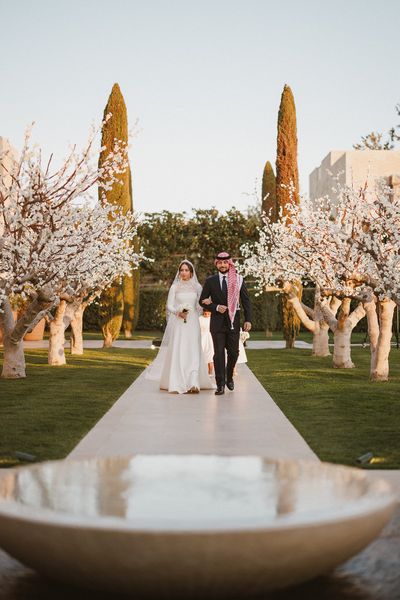In Jordan, a lavish royal wedding doubles as a princely coming-out party

AMMAN, Jordan – A guest list of glitterati from around the world, including Britain’s Prince William and his wife, Kate, and first lady Jill Biden. Elaborate ceremonial events and concerts headlined by top Arab pop stars. An entire capital festooned with flags and banners in anticipation of the big event, with a public holiday announced so that thousands can – if only vicariously – join the fun.
It’s all part of the royal wedding fever that has gripped Jordan as this desert kingdom and key U.S. ally in the Middle East celebrates the nuptials Thursday of Crown Prince Hussein, 28, and Rajwa Alsaif, a 29-year-old Saudi architect who finished her studies at the Fashion Institute of Design and Merchandising in Los Angeles, where she also worked at an architecture firm.
In recent weeks, images of the beaming couple have become a ubiquitous sight, adorning cars, buses and buildings all over the country. You can’t swing a Hashemite ceremonial sword (like the one presented to Hussein as a gift from his father Wednesday) without hitting a sign bearing the occasion’s official slogan, “Celebrating Al Hussein,” complete with logo with stylized Arabic lettering.
Such extravagance is rare for Jordan’s royal family, which heads an impoverished country with few natural resources, chronically high unemployment and 11 million people who often complain about government waste and corruption.
But the event is about far more than the nuptials. It’s a massive coming-out party for Hussein two years after his father, King Abdullah II, thwarted an alleged coup plot involving the former crown prince, his own half-brother, Hamzah, who was accused of conspiring to overthrow the monarch and take over the country. Hamzah remains under house arrest and did not appear Wednesday at various events before the wedding with other members of the royal family.
The alleged plot brought into the open rivalries that the Hashemite dynasty has assiduously tried to keep behind palace doors. It also spurred a raft of criticism of Abdullah, with many contrasting the popularity of Hamzah and his common touch – especially among Jordan’s all-important tribes – with the aloofness of the king.
Abdullah had stripped Hamzah of the title of crown prince in 2004, naming Hussein heir to the throne five years later when the boy was only 15. Over the last decade and a half, the king has striven to raise his son’s public profile, including taking him to the United Nations General Assembly to speak in 2017.
The alleged coup plot in April 2021 only highlighted Abdullah’s need to shore up his family’s legitimacy and their rule over Jordan’s 11 million people. Since then, the promotional campaign for Crown Prince Hussein has gone into overdrive, said Amer Sabaileh, a political analyst based here in Amman, the Jordanian capital.
“It accelerated after Hamzah so as to end that chapter,” he said.
Hussein is now a fixture with his father at most public events and often represents Jordan in meetings with other leaders. Hussein has taken an active interest in economic initiatives, and was dispatched by the king to negotiate Jordan’s 5G rollout with the U.S. and China.
The wedding augurs a more prominent role for Hussein well beyond the constitutional limits of his current position, Sabaileh said.
“He’s no longer a protocol crown prince. It’s clear he’s playing for something greater,” Sabaileh said, adding that Hussein’s pre-wedding celebrations have brought him in direct contact with government officials and the army he is supposed to lead in the future. (In Jordan, the king is the supreme commander of the armed forces.)
On Wednesday, the royal family joined thousands of officials and dignitaries to watch a traditional dance performance and displays of military might that included aerobatic maneuvers by Jordan’s U.S.-supplied F-16s.
State television has featured nothing but wedding-related content for days, including interviews with the crown prince and his family and live broadcasts of events, all interspersed with constant commentary from guests gushing effusively about the importance of the occasion.
The wedding starts Thursday afternoon, with some 1,700 guests. A large motorcade is planned, with many parts of Amman blocked off for the bride and groom to make their way to one of the royal palaces west of the capital. One private news channel spent minutes speculating as to which of the royal family’s collection of classic automobiles – Abdullah’s father, King Hussein, was a huge car aficionado – would bear the couple to Husseiniya palace.
Hussein’s choice of Alsaif as his wife carries potential political benefit for Jordan. Her father, Khaled Alsaif, leads one of Saudi Arabia’s largest contracting companies. Her mother is a Sudairi, meaning that she’s a relative of the mother of Saudi Arabia’s King Salman.
Jordan and Saudi Arabia have had a hot-cold relationship. The Hashemites originally hail from Saudi Arabia and historically competed with the House of Saud for control. In years past, Saudi Arabia was a lifeline, investing and pumping aid into Jordan’s perennially strapped economy. But that aid has dried up in recent years as Saudi Arabia and other oil-rich states focus on their own development.
Jordan hopes to capitalize on Saudi Arabia’s “giga-projects” – colossal developments like the Massachusetts-sized megacity Neom, which includes plans to create links to the Jordanian coastal city of Aqaba and cities in Egypt.
The union of Alsaif and the crown prince appears to have been well-received in Riyadh, the Saudi capital. Arab News, the Saudi state-owned English-language newspaper, plastered a picture of the couple on its front page with the headline: “The kingdom’s bride and joy.” It also featured an interview with Jordan’s ambassador to Saudi Arabia, Ali Kayed, who spoke of how the two countries were “a model of cohesion in Arab relations.”
“There are no cultural differences between Jordan and Saudi Arabia,” Kayed said.
“They are united by an inherent brotherhood, a similar heritage, and neighborly relations cementing the bonds of love and strength between the two peoples.”